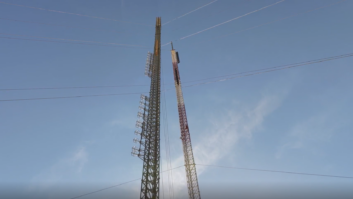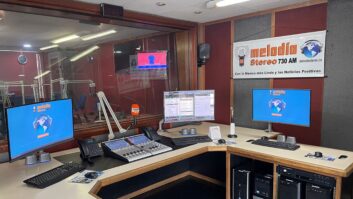Radio World asked several of our contributors to attend various sessions at the NAB2003 convention. Here, Michael LeClair summarizes presentations at “IBOC DAB – Ready For Prime Time” of the Broadcast Engineering Conference.
Milford Smith, vice president of engineering for Greater Media Inc., moderated the first part of the session by introducing five industry professionals presenting papers on various aspects of HD Radio implementation.
“Chipping Away at the HD Radio System” – With HD Radio being deployed in a number of top markets in the United States, interest in consumer receivers is increasing. John Gardner, worldwide marketing manager for Texas Instruments, presented an overview of the development of HD Radio tuners from the perspective of an integrated circuit manufacturer.
Gardner reviewed major subsystems of an HD Radio receiver, including the RF tuner, digital conversion of analog baseband, digital demodulation for HD Radio and conventional analog demodulation for standard AM/FM audio services. With the use of custom chips designed for HD Radio services, three integrated circuits can accommodate these major subsystems.
Although current-generation HD Radio tuners are designed to provide the main digital audio program material (with simple text displays) in addition to analog programs, Gardner said the basic digital signal processing core has been developed and will not need to change further. This should assist receiver development because advanced graphic features, such as program associated data, a second audio program channel and store and playback functions can be accommodated by this system as manufacturers look to develop future products.
“Swept Frequency Techniques for Evaluating AM Antenna System Bandwidth” – AM stations looking to deploy HD Radio must ensure that their antenna systems provide adequate bandwidth to transmit the sideband digital carriers successfully.
To illustrate his suggestions on how to speed and improve the testing process, particularly for AM directional stations, Ronald Rackley, P.E., of duTreil, Lundin and Rackley Inc. discussed how network analyzers may be used to make impedance sweeps on directional arrays.
Rackley said traditionally network analyzers have been unusable for AM antenna measurements because of interference from other AM band stations on tall towers. The interfering signals overwhelm the desired test signal and the network analyzer “kind of loses its mind,” Rackley said.
By using an amplified signal generator, then attenuating the return signals from the antenna, the signals used to sweep the antenna are high enough in amplitude that the interfering radio signals do not overload the network analyzer.
Rackley designed and built his own directional coupler for use with this technique, as no commercial directional couplers are available with sufficient power handling capability in the AM band, he said.
Rackley reviewed 50 proof-of-performance reports randomly from his files to get an idea of how many of these stations would meet the current guidelines from Ibiquity Digital Corp. for antenna system bandwidth. The results indicated that approximately half of today’s directional antenna systems would need some adjustment or improvements to broadcast digitally.
“FM IBOC Transmission Using Dual-Input Antennas” – Many engineers have expressed an interest in the use of “space combining” as an alternate method of implementing digital radio that avoids the power losses associated with both high- and low-level combining. Eric Wandel, P.E., of Electronics Research Inc. discussed the options for this technique.
Wandel clarified that the current blanket authorization from the FCC specifically requires that both the digital and analog carriers must excite all elements of the antenna. Station personnel would need to apply for a Special Temporary Authorization from the FCC in order to use a dual antenna to implement IBOC.
“We feel that the separate antenna approach is very feasible,” said Wandel, “but from a regulatory perspective there is still risk,” because it’s unknown how the FCC will treat the dual antenna approach in its final IBOC rules.
An ad hoc committee of the NAB is trying to determine under what criteria the commission would approve the dual antenna approach so that stations could use this technique before the agency issues final IBOC rules.
Wandel reviewed suggested criteria for blanket approval of separate antennas. Under these proposals, a separate antenna system must use an approved auxiliary antenna for the FM main signal, have a HAAT of between 70-100 percent of the main antenna and be within 3 seconds of latitude/longitude. Also, both the analog and digital must operate non-directionally.
“What really happens as a result of the testing could end up a lot different than this,” Wandel cautioned.
NAB is overseeing the testing of separate antennas under different conditions at several stations. Most critical to the successful implementation of digital radio is the matching of the radiation patterns in the horizontal plane, which maintains the amplitude ratio of the digital to the analog carriers intact. Changes in this ratio due to different antenna patterns can cause degradation to either the digital or analog service.
Regarding an interleaved antenna, in which alternate elements are radiated with analog, and then digital signals are placed on the elements in between, Wandel said, “We recommend caution on that right now,” due to the effect of the interleaved antenna on the vertical plane pattern. The resulting antenna is less efficient, reducing coverage area.
Finally, Wandel discussed dual-input antennas. These can be constructed with either new or existing panel antenna systems, Wandel said. While expensive, he said, panel antennas offer a good way to implement digital operation with excellent match between the analog and digital patterns.
“AM High-Definition Radio – Technical Issues Affecting Adoption at Night” – Glen Clark, P.E., of Glen Clark and Associates said the main reason the FCC limited IBOC authorizations for AM to daytime is to protect analog services from adjacent-channel skywave interference caused by digital sidebands. The sidebands are more than 10 kHz away from the center frequency.
As groundwave represents the main revenue-producing signal for AM stations, interference to this service affects the ability of AM stations to continue operations during digital transition.
“This is not an easy problem to solve,” said Clark, because of the legacy FCC allocation schemes in place.
To get a better understanding of the impact of this kind of interference, “We did a statistical study of the nighttime evaluations we have done for clients over the last 10 years,” said Clark.
Clark evaluated the potential for nighttime interference with digital operation with this set of stations. In many cases, based on FCC criteria, no interference was predicted and digital operation should be possible immediately, he said. In other cases, the reduction of power in one or both of the digital sidebands by 6 dB would eliminate predicted interference. In only one case would it have been impossible for the station to operate at night without causing interference.
AM directionals were included in the study.
If the results of this study are representative of the entire AM band, Clark said, of the 2,800 stations licensed to operate full-power AM at night, approximately 1,800 stations would be able to run full-power digital carriers without causing interference. An additional 873 stations would need to reduce the power in one or both of their digital sidebands, and 95 stations would not be able to operate without interference.
Clark believes many of these interference problems could be resolved over time by directionalization. Earlier this year, Clark filed a petition for reconsideration with the FCC arguing that there is no reason to prevent nighttime implementation of HD Radio for the majority of AM stations (RW, March 12, page 2).
“IBOC Technical Activities Report” – David Layer, director of advanced engineering, NAB, Science and Technology, said Ibiquity has licensed 130 stations to operate digitally, and the company predicts the number would increase to 300 by December.
The DAB Subcommittee of the National Radio Systems Committee is working to develop a final IBOC standard to submit to the FCC so that it can be incorporated into the rules. Due to the availability of test results, Layer expected the work on the FM IBOC system to be completed first, followed by a standard for AM.
Another issue being considered by the NRSC is the need for a standard for data broadcasting, and the degree to which an open standard can be created that protects Ibiquity’s intellectual property.
Layer commented on the importance of the NRSC submissions to the FCC and the influence of the group on final rulemakings.
He also reviewed NAB activities; the association is also working on the IBOC rollout. An ad hoc group is working with Ibiquity to study AM IBOC nighttime performance and another group is testing the dual-antenna approach to IBOC for FM.
Clear Channel Radio Senior Vice President for Engineering Services Jeff Littlejohn moderated the second half of the all-day IBOC panel, which included eight speakers. RW covered the highlights.
“Practical Considerations for the Implementation of AM IBOC” – WOR(AM) claims to be the first AM station in New York to begin regular digital transmissions. Thomas Ray III, Corporate Director of Engineering for Buckley Broadcasting, shared experiences about the station’s digital birth.
“If you look at the trades, the first thing you think you have to do is to gut your facility” to convert everything to digital, said Ray. To the contrary, Ray found that even his vintage studio facility, which still includes turntables, sounds “just fine” with IBOC. The transmitter and STL were left intact for digital, although Ray noted that his auxiliary transmitter probably would not pass the IBOC waveform.
In a deviation from Ibiquity recommendations, Ray said the bandwidth of the analog audio was limited to 6 kHz instead of 5 kHz to reduce the impact of IBOC on the WOR analog signal.
Regarding the antenna system, Ray said the WOR three-tower array includes filtering for two nearby AM stations. Because of this, the antenna system did not exhibit common point impedance as flat or symmetrical as recommended by Ibiquity.
In spite of this system limitation and the extended analog frequency response, digital coverage extended about 95 miles in their tests.
Ray said there were a few issues created by the 8-second delay that Ibiquity’s technology adds to the audio stream to keep the digital and analog audio in sync. Network automation had to be adjusted to compensate for the delay. Listeners to sports broadcasts complained, particularly if they were in the stadium and listening to a portable radio to follow the play-by-play action.
All in all, the experience has been a good one for WOR, whose employees are proud to be one of the first facilities to deploy HD radio, he said.
“We’ve had a lot of positive response from listeners. They want to know where they can buy an HD radio,” said Ray.
“A Planning Guide: Determining the Best IBOC Migration Path for Your AM or FM Station” – Keith Mullin, senior technical communicator for Harris Corp., discussed a basic foundation for IBOC planning. In order to go digital, station chief engineers will need to consider studio needs such as their audio source, wiring and processing.
Early adopters are telling Harris that STL systems need special attention.
“After the transmitter upgrade and cleaning up any antenna issues, STL chains are the second-most critical portion of the IBOC migration process,” Mullin states in his paper.
Transmitter site needs include power, HVAC and grounding protection.
Whether a station will stream its content over the Internet or use the datacasting ability of Ibiquity’s system in the future are issues to keep in mind for IBOC planning purposes.
“The Effects of Implementation of IBOC Transmissions on Nighttime Analog Reception” – As part of the research on the effects of nighttime AM IBOC transmissions, Ibiquity undertook an extensive statistical study to predict potential interference for all AMs with nighttime service. Glynn Walden, vice president of broadcast engineering for Ibiquity, showcased the results.
Ibiquity wanted to nail down what kind of analog interference exists now among AMs operating at night. Every AM in the country with nighttime service was considered and all signals were calculated at 4-mile intervals (more than 37,000 geographic cells were considered) using standard FCC propagation calculations.
In conjunction with gathering this data, Ibiquity commissioned subjective radio tests with 120 untrained listeners using four kinds of radios. Testers gave numerical scores to show at what point interference made audio “unlistenable” to the average user, using a Mean Opinion Score scale to evaluate audio quality.
To replicate the effects of digital carriers, interference was tested for both program audio and full modulation white noise. Walden said co-channel interference with current analog transmissions was by far the worst problem.
“General population testing found the effects from two sources of audio extremely annoying,” said Walden.
Finally, these interference ratios, developed for co-channel, first- and second-adjacent interfering signals, were overlaid on the contour coverage data obtained in the comprehensive study of AM stations. The result was a map that shows exactly how much interference AM stations now experience at night due to skywaves and groundwaves.
Ibiquity also created a map of what could be expected if all AM stations were to immediately start broadcasting IBOC transmissions at night. Walden said in most cases, results showed nighttime IBOC transmissions would not degrade analog reception by more than a small amount.
“Co-channel analog remains the largest contributor to nighttime interference, and will be so after IBOC has been implemented,” said Walden.
“IBOC Space Diversity Test” – Research continues into the use of dual antennas for digital radio. Using his paper, “IBOC Space Diversity Test,” J. Talmage Ball, vice president for engineering of Bonneville International, relayed the results of his investigation into the dual-antenna approach to IBOC implementation. Ball conducted field tests at Bonneville International’s KDFC(FM), a classical station in San Francisco.
“The Bay area exhibits every kind of multipath challenge to FM radio conceivable,” said Ball. “What I really wanted to do was take IBOC and put it in its worst-case scenario.”
Ball built and tested two IBOC transmission facilities at the same mountain site. As a control system, standard high-level combining was used over the KDFC(FM) main four-bay antenna.
A different model two-bay antenna on a separate tower was also installed using a low power amplifier for the IBOC-only signal. Performance tests were conducted, measuring first one system and then the other over the same coverage area.
Ball took continuous measurements over a series of four rough radials extending out from the mountain transmitter site, while monitoring both the analog and the digital transmissions for impairments. Ibiquity provided the monitoring equipment for the IBOC signals.
Results demonstrated that IBOC performance was similar between the high-level combined system and the separate antenna system, with the exception of a null around 5 miles from the transmitter site where the dual-antenna system did not work as well. Ball suggested that this may have been due to the different vertical plane radiation patterns developed by the two antennas which had different numbers of bays and different mounting structures.
Ball also said that with both antenna systems, the ratios between the analog and digital carriers deviated from their specified values as the routes were driven, indicating the effects of multipath interference.
In spite of this, neither antenna system caused any audible degradation to the analog performance of the main channel FM. “We could not hear the IBOC switched on and off,” said Ball, “even though (in certain locations) the IBOC power ratios (were) higher than the analog.”
“Solutions for the Implementation of FM IBOC Technology” – Henry Downs, principal engineer for Dielectric Communications, reviewed IBOC implementation methods.
He stated in his paper, “The interleaved antenna, which (uses) the reverse polarization interleaving technique, may prove to be the solution of choice. However, the current investigations being carried out using separate antennae will, once endorsed by the FCC, allow further solutions to be offered.”
Other sessions included “Reducing FM IBOC Transmission Costs with the Proper Configuration and Linearization Techniques” with George Cabrera, principal electrical engineer of Harris Corp.; “Applying the Principles of Data Communications to the Development of an Open and Universal IBOC Data Protocol” with David Maxson of Broadcast Signal Lab LLP and Paul Signorelli of Impulse Radio; and “Digital Radio Concepts for Satellite and Terrestrial Reception” with Jack Morgan of Philips Electronics.







